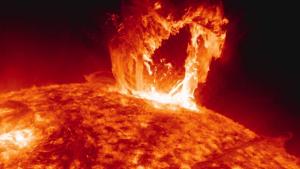Blog
Is the Sun
Losing Mass?
16 December 2015
 NASA/JPL
NASA/JPLYesterday’s post about Earth’s changing mass raised similar questions about the Sun. In the Sun’s case we know that it’s losing mass, and at a rate fast enough that it’s forced us to change the way we measure astronomical distances.
The Sun loses mass in two major ways. The first is through solar wind. The surface of the Sun is hot enough that electrons and protons boil off its surface and stream away from the Sun, generating a “wind” of ionized particles. When those particles strike Earth’s upper atmosphere they can produce aurora. The solar wind varies a bit in intensity, but from satellite observations we know that the Sun loses about 1.5 million tonnes of material each second due to solar wind.
The second way the Sun loses mass is through nuclear fusion. The Sun fuses hydrogen into helium in its core, producing its life-giving glow over billions of years. The production of helium transforms some of the hydrogen’s mass into energy, which radiates away from the Sun in the form of light and neutrinos. By observing just how much energy the Sun radiates, and using Einstein’s equation relating mass and energy, we find the Sun loses about 4 million tonnes of mass each second due to fusion.
So the Sun loses about 5.5 million tonnes of mass every second, or about 174 trillion tonnes of mass every year. That’s a lot of mass, but compared to the total mass of the Sun it’s negligible. The Sun will keep shining for another 5 billion years, and by that time it will have lost only about 0.034% of its current mass.
While the amount of mass loss is negligible, it isn’t zero, and it has an effect on Earth’s orbit. As the Sun loses mass its gravitational pull on the Earth weakens over time. As a result, Earth is receding slightly from the Sun. Because of solar mass loss the Earth’s distance from the Sun increases by about 1.6 centimeters per year. In astronomy, one of the ways we measure distance is through the astronomical unit, which has traditionally been defined as the distance from the Sun to the Earth. For most of astronomical history the changing distance of Earth was too small to consider, and so the astronomical unit could be considered a constant. But over time our measurement of this distance has become astoundingly accurate, and currently has a precision of about 3 parts per billion. This is accurate enough to observe the gradual increase in distance. So in 2012 the astronomical unit was defined as fixed constant. As a result the Earth is slightly more than 1 astronomical unit away from the Sun.